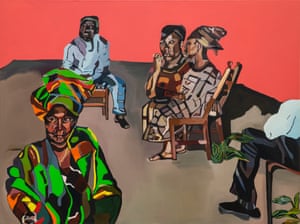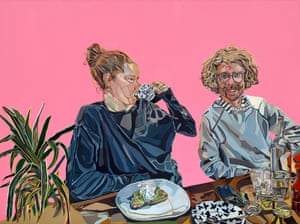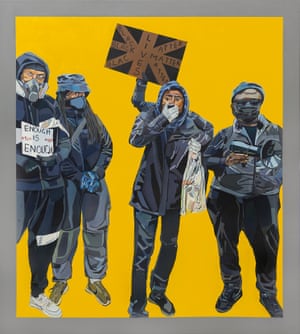Joy Labinjo: ‘When I’m painting I feel happy and alive’ | Art and design
[ad_1]
“I like coming to the studio and it just being me,” British-Nigerian artist Joy Labinjo says when I ask whether she gets lonely. The 25-year-old’s career has risen rapidly since graduating from Newcastle University in 2017. That year she won the Woon art prize, then in 2019 had a solo exhibition at the Baltic; she now has works in the current Royal Academy Summer Exhibition and a forthcoming mural commission at Brixton station, south London. At Frieze London last autumn, three of her paintings sold within two hours of the fair’s opening. All of which means she is very busy. Of course she’s spending less time with her peers because of the pandemic, but she is fine with living up to the isolated artist trope. “It’s easier to focus with fewer social engagements,” she says.
My question is partly sisterly concern. I think back to private views, biennales and gallery weekends that I’ve attended without another black person in sight. This is familiar territory for Labinjo. Her work, mostly large-scale, colourful, striking portraits inspired by archival family photographs, initially stemmed from the absence of black people in her academic environment and the teaching material. “What I was being taught wasn’t broad enough,” she says. “I first started using family photographswhen I was at Newcastle – it was the easiest way for me to access the black figure.”

She initially planned to write her dissertation on the Young British Artists but changed her mind after discovering artists such as Lubaina Himid, Keith Piper, Donald Rodney and Sonia Boyce, who were associated with the British black art movement of the 80s. “What interested me about them was their energy and perseverance,” she says. “How they teamed up, had so many knock-backs, had exhibitions in corridors! When I was writing my dissertation, Brexit was happening, the far right was gaining prominence in the UK, so it felt like the things these artists were making work about in the 1980s were happening again,” she says. “They were so bold. How Eddie Chambers ripped the flag up in Destruction of the National Front, I was like: ‘Yes!’ It was what I needed at the time.”
Labinjo was born and raised in Dagenham, east London, to Nigerian parents. Her paintings are rooted in her heritage, from vividly capturing traditional west African patterned attire to her depiction of culturally intimate scenes, but her work has recently taken a new direction. “After the Baltic exhibition, I knew I wanted to step back from family photos because I didn’t want that to be my whole practice,” she says. “I wanted to paint my friends. I wanted to paint people of all races.” One of the paintings at the RA is titled Breakfast With Violet and Adam and is thematically and stylistically different from her older works. “I pushed myself to paint things I wouldn’t normally. So the plates, the glass, the salt and pepper shaker. I painted her wispy hair, her freckles. It was a challenge for me, but I really enjoyed it.”
But then George Floyd was killed; and a video emerged of a white woman calling the police after a minor altercation with a black man in New York’s Central Park; in London a Metropolitan police officer was filmed apparently kneeling on a black suspect’s neck during an arrest, and the athlete Bianca Williams was stopped, searched and handcuffed. These incidents deeply affected Labinjo and caused a sudden change of heart. “In the grand scheme of things, I don’t know if that work is important,” she says, reflecting on the paintings featured in the Summer Exhibition. “It might have been more special to have had portraits of black people taking up space there. Portraits of white people exist in so many institutions.”

Labinjo channelled her anger and the energy from photographing scenes at Black Lives Matter protests in London into a new series of paintings, much darker in tone, featuring police officers, protesters and businessmen. “I still wanted to paint white people just to prove that I could, but this time they could be the butt of the joke. I’m using them as characters to talk about racism as a structure. So when white people appear in the paintings, they are quite humorous,” she says. “The other works speak to the effects of colonialism. In Britain, a lot of people honestly don’t know about the empire and how Britain’s wealth was accumulated. To an extent, it’s not their fault, because we were not taught about it in school. If, as a country, we understood the atrocities that have taken place, it would provide context.”
Labinjo is a part of a new wave of artists of African origin who are coming to prominence. While she doesn’t believe that there is a defined “black” aesthetic, she has noticed similarities between her work and other contemporary figurative painters. “There are maybe 10 artists, including Amako Buffou, Toyin Ojih Odutola, Njideka Akunyili Crosby and Kudzanai-Violet Hwami whose work is less photo-realistic, less expressive, but has lots of colour. This whole flatness, the way we see colour – some people are perhaps doing it to look good digitally.”
Labinjo’s paintings are often constructed from collages she creates digitally using images sourced from Instagram, furniture websites, catalogues and personal and local archives. Attention to detail is something she takes pride in, even down to her tools and materials. “The paint I use is all one brand: Michael Harding. Brushes are really important, too. I always need to buy lots of the smaller brushes as I get through those quickly. Using angled flat brushes is how I get the chiselled look.”
When she’s not making art, Labinjo is reading, watching and listening, from Bernardine Evaristo’s Girl, Woman, Other to Candice Brathwaite’s I Am Not Your Baby Mother to Michaela Coel’s I May Destroy You. “I was also inspired by Michaela Coel’s MacTaggart lecture, which reinforced that people take in stories easier than hardcore political messages. She didn’t use words like race and class, she just told stories. It made me realise what a powerful medium storytelling is.”
Though she has a solo show opening at Tiwani Contemporary in London in December Labinjo does not take success for granted. She recently enrolled on the MFA programme at Oxford University’s Ruskin School of Art. “It wasn’t until I studied in Vienna for a semester that I gained some self-belief. Everyone in the UK was like: ‘You’re doing a Mickey Mouse degree.’ But in Vienna, it was a really valued subject. It was respected.”

What does she make of the government’s skills assessment initiative, which has been encouraging artists to retrain in other professions? “It’s quite funny – they’re telling artists to retrain, when most artists do other things anyway. Very few artists get to just do their art.” According to a 2018 survey, 60% of artists have to take second jobs in order to pay the bills. “In some ways I think it takes more to shut creative people down because by 18, you’re already very invested. But maybe 14, 15-year-olds might think they’re going to pick different GCSEs. My flatmate works for an education charity helping kids after school apply to university. A lot of working-class and BAME people don’t want to go into the arts because their families have been struggling their whole lives and they don’t want to struggle further.”
Labinjo says a world without art would be bleak, and it’s hard to disagree. “We see through the pandemic, life is hard for people, and it is art, TV, online theatre, films, that get people through. From a book cover to a cereal box to TV shows, to the adverts between the TV shows to the music we listen to. I don’t think people realise how important art is.
“When I’m painting I feel happy and alive,” Labinjo adds fervently. “Sometimes I’m not present. If you call my name, I’m not there. That feeling of being transported somewhere else – that’s when I know I’ve hit the mark.”
• Joy Labinjo’s solo exhibition is at Tiwani Contemporary, London, from 2 December
[ad_2]
Shared From Source link Arts